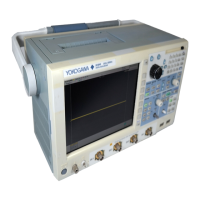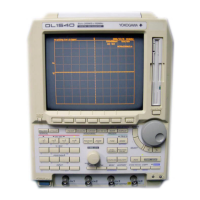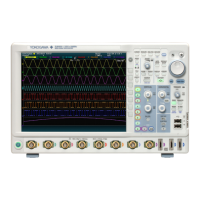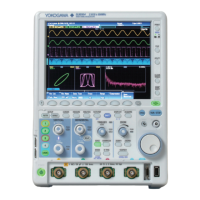10-84 IM 701450-01E
• Enable Status of the CS Signal
You can select the enable status of the CS signal. The setting applies to all CS signals.
H For a channel signal, this is the status when the signal is higher than the level for
determining the status of the CS signal. For a logic input signal, this is the status when
the signal is 1. The I/O data is analyzed when the CS signal is H.
L For a channel signal, this is the status when the signal is less than the level for
determining the status of the CS signal. For a logic input signal, this is the status when
the signal is 0. The I/O data is analyzed when the CS signal is L.
X Select this status when not determining the status. All the I/O output data are analyzed. The byte
boundary of the data being analyzed is the point where the CS signal changes from high to low or
low to high. This status cannot be selected when multiple signals are enabled as CS signals.
– When none of the signals are enabled as a CS signal, this indicator is displayed and
cannot be changed. All the I/O output data are analyzed. The data to be analyzed is the
I/O data that is divided at the byte level from the analysis reference point (see the next
page). Select this status when analyzing the I/O data without using the CS signal.
• Priority
Priority exists in the CS signals. When multiple CS signals are enabled, the I/O data
corresponding to the CS signal with a high priority is analyzed. The priority in
descending order is CH4, CH5, ... , CH8, PodA A0, A1, ..., and A7. When the
analysis data is displayed, the name of the CS signal (CH4, CH5, ... , CH8, PodA A0,
A1, ..., and A7) that was used when the I/O data was analyzed is displayed in the
location where the enable status of the CS signal is displayed.
Reference Point of the Analysis
You can set the reference point where the analysis is to start. The first analysis data as
viewed from this reference point is assigned the analysis number 0. For details on the
assignment of the analysis number, see “Analysis Numbers” on page 10-85.
Trigger Sets the reference point to the trigger position.
Manual You can set the reference point in the range of ±5 divisions. The resolution is 10
division÷display record length.
Read Direction of the I/O Data Bits
You can select the read direction of the bits according to the signal flow. When analysis
data is displayed in binary, the data is displayed in the order of the flow regardless of the
bit order setting. When analysis data is displayed in hexadecimal, the data is displayed
according to the setting, separated every four bits in the order of the flow.
MSB First Select this when the I/O data signal is flowing MSB first.
LSB First Select this when the I/O data signal is flowing LSB first.
Data
1 1 1 0 1 0 0 0 0 0 1 1 0 001
When set to MSB First: E831
When set to LSB First: 71C8
Range That Can Be Analyzed
Up to 80000 bytes of analysis data can be displayed. The displayed result varies
depending on the number of bytes analyzed as follows:
• When the total analysis data is less than or equal to 80000 bytes
All points are displayed regardless of the position of the reference point.
10.11 Analyzing and Searching SPI Signals
